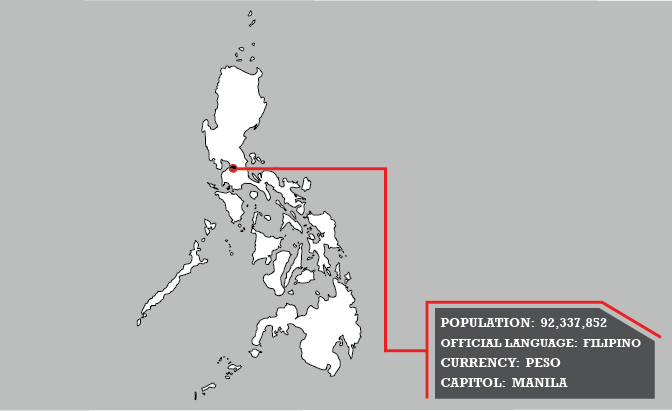Philippines

COUNTRY PROFILE
The Philippines is full of natural beauty, including gorgeous beaches, hills that look like candy drops, amazing waterfalls, old rice terraces and reefs full of marine life. But you are not likely to see such wonders unaccompanied, as the locals are very outgoing. They consider solitude seekers an oddity—Filipinos prefer to have company. The locals' jokes, smiles and laughter will be shared with their visitors—such friendly people are rare.
Philippine history has been summed up in two very different eras of colonial domination—first by Spain and then by the U.S. Both eras began with naval actions. The first was in 1521, when Spanish explorer Ferdinand Magellan came upon the islands during the first round-the-world voyage, but foolishly became involved in local politics and was killed by Lapu Lapu, a tribal chieftain now immortalized as the first Filipino to resist foreign rule.
The islands were governed by Spain until 1898, when the nation became the only official overseas colony of the U.S., following Adm. George Dewey's victory over a Spanish fleet in Manila Bay. A U.S.-Filipino war followed the Spanish-American War and ended only when Emilio Aguinaldo, the Filipino leader, was captured by U.S. troops during negotiations. Aguinaldo did, however, extract a promise for independence—a promise that was kept in 1946 after an intervening war and occupation.
The most infamous chapter in Philippine history began when Ferdinand Marcos was elected president in 1965 and re-elected in 1969. Barred by the constitution from seeking a third term, he declared martial law in 1972 and rewrote the constitution. Over the next 15 years, his government became one of the most corrupt in the world. Estimates vary, but it is possible Marcos siphoned billions from the Philippine treasury—while his constituents became some of the poorest people in Asia.
Facing a rising tide of discontent, Marcos called an unscheduled election in 1986—and lost, despite a massive effort to steal the vote. He fled the country and died three years later. Ensuing leaders have made some progress in alleviating the country's endemic corruption and poverty. However, Contrary to commonly held notions, the Philippine economy performed well from 2004 to 2007 with four years of consecutive domestic growth. One of the biggest boosts to the Philippine economy is the billions in annual remittances sent there by Filipinos who have emigrated to other countries as residents or as overseas contract workers.
The barong tagalog is the country's national costume for men. It is made of translucent and lightweight material that is perfect for Philippine weather. Historical legend suggests that the reason for the apparel's transparency can be traced back to Spanish colonial times when Filipinos were strictly monitored for carrying weapons.
There are more than 80 languages and more than 100 dialects spoken in the Philippines, but most residents also speak English. Filipino schools are based on the U.S. system, and the language of instruction is English.
The Philippines is the only Roman Catholic nation in Asia.
DATES
Call for custom dates.
AGE REQUIRMENT
13 and up



